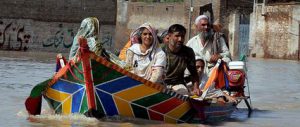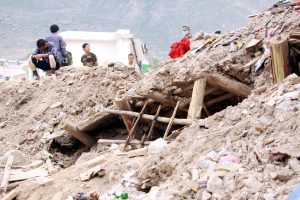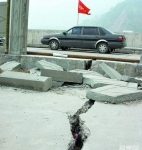Devastating natural disasters have killed close to a million people and caused billions of dollars of damage in the past few years. Despite its sophisticated technology, humanity remains hugely vulnerable to earthquakes, hurricanes, volcanic eruptions and other calamities. The danger is only likely to increase, say geologists and weather experts. Earth’s swelling numbers are forcing more and more people to live in geological and meteorological danger zones. As a result, death tolls are destined to rise.
In addition, human impact on the climate, which is warming relentlessly as more and more carbon dioxide is pumped into the atmosphere from cars, factories and power stations, will also worsen the problem. At higher latitudes, melting glaciers and ice sheets will modify the pressures acting on tectonic plates and volcanoes, potentially provoking more earthquakes and eruptions, while rising sea levels will leave many regions more vulnerable to hurricanes and storms.
Our planet needs help, badly, and Bill McGuire, professor of geophysical and climate hazards at University College London, believes he has a solution. We need a global clearing house in which details of all major natural threats are stored, evaluated and updated. All governments and other stakeholders can access the repository to obtain specific information on the hazards that threaten them, whether storm, quake, volcanic blast or tsunami, he says.
Robin McKie: There have been several recent catastrophes, including earthquakes in Haiti, Chile, New Zealand and Japan. Would the global clearing house you propose have helped lower their death tolls?
Bill McGuire: Not in every case. The earthquake in Japan, which triggered the tsunami on 11 March, arose from a geological fault that was not thought to be capable of releasing such devastating energies. The Christchurch earthquake in February, which killed more than 180 people, was set off by a fault that geologists did not even know about.
However, there have been many other examples in which dangers had been raised by geologists but which were not then passed on to governments or emergency managers, or at least not acted upon. Consider the Haitian earthquake of January 2010. It caused more than 250,000 deaths and up to US$14 billion of damage. Yet a scientific paper had been published a year earlier that contained a quite specific warning that the area was at high risk of suffering a major earthquake. Similarly, the dangers of the Chilean earthquake of February 2010, which caused around 500 deaths, had been highlighted in advance in another scientific paper.
On a personal level, I warned the [UK] ministry of defence several years ago of the dangers to aviation that could be posed by a major Icelandic volcanic eruption. The chaos that reigned when Eyjafjallajökull erupted in 2010 and our air transport was paralysed suggests that the warning had little influence on government preparedness.
RM: Can you pinpoint any places that are at risk of disaster in the near future?
BM: Yes. There are several. The Boxing Day [December 26] tsunami of 2004 in the Indian Ocean was triggered by a massive release of energy on a geological fault. However, there is one section along that fault which has still not released its energy. That could be triggered very soon. When it does, it is likely to cause a major earthquake and a tsunami with the potential to swamp the city of Padang, in Sumatra, and its population of more than 800,000 people.
On the other side of the world, it is known that the Caribbean experiences a major earthquake – that is, measuring more than 8.0 on the Richter scale – sometimes accompanied by a tsunami, every 50 years on average. There has not been one for more than 60 years, however (last year’s Haiti quake measured 7.0). So the level of concern is growing.
RM: It is one thing saying such risks exist, but how can ordinary people deal with them?
BM: That is a harder question to answer, and the key is better warning systems. To have these, however, you need to know the nature of the threats, which is where the repository comes in. There is movement, but it is slow. The Caribbean tsunami threat is now taken seriously enough that a warning system is planned. Without it, a big sub-marine quake in the future could see a tsunami crashing without any warning on to the shores of islands distant from the quake epicentre.
Even when and if a warning system becomes operational, there is still some way to go before a message that a wave is on its way can be transmitted in good time to the guy who runs that bar on the beach and to the people who are drinking there.
But effective warning systems need good, reliable information about the hazard they are intended to warn against, which is where the repository comes in. The idea is not new and was recommended by a committee, of which I was a member, established by [former British prime minister] Tony Blair after the 2004 tsunami. Despite the interest of the UN, there has been no further progress.
RM: Do you believe we will face increased risks of such events in future?
BM: Yes. The projected two billion rise in the world’s population [to nine billion in mid-century] will inevitably mean that far more people are vulnerable, particularly in the great coastal megacities of the developing world. In addition, we know from studies of periods of abrupt environmental change from the past – for example after the end of the last ice age – that ongoing climate change is likely to drive more geological hazards. Already the loss of ice in Alaska is driving more earthquakes, while rising temperatures in mountainous regions are provoking a rise in the numbers of massive landslides.
Future ice loss and bending of the crust due to rising sea levels have the potential ultimately to raise levels of both earthquake and volcanic activity. In short, we may well see a response from the solid earth to climate change and we need to be prepared for that.
https://www.guardian.co.uk/
Copyright © Guardian News and Media Limited 2011
Homepage image by Takashi Nakano shows earthquake and tsunami damage in Sendai, Japan.


